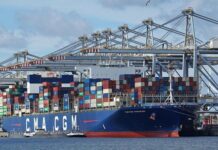
The Long Beach Board of Harbor Commissioners has approved a cooperative agreement with the South Coast Air Quality Management District (SCAQMD) and the Port of Los Angeles to accelerate the development of zero-emission infrastructure across the San Pedro Bay port complex.
The unanimous vote on Monday establishes enforceable deadlines and commitments for both ports to plan and implement clean-air initiatives. The SCAQMD Board approved the same agreement on November 7.
Under the plan, the ports will prepare zero-emission infrastructure blueprints in three phases. A draft plan is due by May 2027, with finalized plans for all equipment categories expected by the end of 2029. The initiative expands on the Clean Air Action Plan (CAAP), which has already reduced diesel particulate matter by 90 percent, nitrogen oxides by 68 percent, and sulfur oxides by 98 percent since 2005.
The ports and SCAQMD will also pursue additional “CAAP Plus” measures to cut emissions from oceangoing vessels, the largest pollution source at the complex. These could include incentives through the Environmental Ship Index program, investments from the Clean Truck Fund to support zero-emission truck adoption, and an annual review of spending priorities with SCAQMD.
Long Beach Harbor Commission President Frank Colonna said the agreement reflects a continued commitment to cleaner operations. “It will deliver tangible results and a sustainable future without risking jobs or cargo throughput,” he said.
Port of Long Beach CEO Mario Cordero praised the collaboration behind the agreement. “Together, with the participation of the ports, SCAQMD, labor, industry, and community partners, I am confident we can reach our shared goal of a zero-emissions future,” he said.
Mayor Rex Richardson called the decision a milestone for both environmental and economic progress. “By accelerating zero-emission infrastructure, we will deliver cleaner air, healthier neighborhoods, and a greener global supply chain,” he said.





